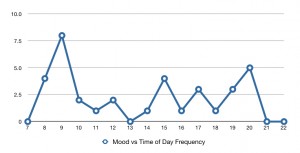Navanit Arakeri, who is 31 and lives in Bangalore, sent me the following email about the effect of looking at faces in the morning:
Thank you, it’s the most extraordinary thing. It’s taken my average daily mood from 6/10 to about 8/10 [on a 1-10 scale where 1 = very, very bad mood, 5 = neutral, and 10 = amazingly good mood. 6/10 = just better than neutral and 8/10 = very good. Note: if 5 = neutral, then a 1-9 or 0-10 scale will work better than a 1-10 scale] It has made me officially “happy”. And much more emotionally resilient to irritants and bad news.
I do it on waking at around 8:00 AM every day. I play “morning news” videos on mute on my iPad with no zoom (so it’s much smaller than life-sized). Example video
I do it for only 20-40 minutes, usually around 25 minutes. I’ve been doing it for about 45 days now.
I’m seeing a few interesting differences compared to your experience:
1. I don’t get the evening irritability at all. In fact, sometimes I get a Big Mood Improvement (see #2) in the evening (around 8:00 PM). The evening effect doesn’t happen every day, while the morning improvement is much more consistent.
2. Sometimes the mood improvement is so strong that I have an involuntary smile on my face. I can sit and stare into space feeling very happy. . . .
Sleep quality has been good throughout.
What led him to try it? “I wanted a simple self-experiment to test my lifelogging iPhone app and this fit nicely. I had read your original self-experimentation paper several years back, but never got around to trying it,” he said.
How long before he could tell it was working? “It was very clear by the 3rd morning,” he said.
He recorded the “involuntary smile” states, which lasted 30-60 minutes, on his iPhone. This graph shows how often they happened versus time of day over a 33-day period:
A value of 8, for example, means that there was roughly a one-quarter chance that during that time period he would be in the “involuntary smile” state. Before this the likelihood of involuntary smiles was zero.

Involuntary smiles is a nice idea of rating mood. Random querying is automatically part of the system.
This post inspires me to look into trying morning faces again; the difficulty of finding the faces sources and the time investment put me off it. So many ideas to try.
Seth, when I read your blog, sometimes I think that I’m reading some amazing Nobel Prize-worthy science.
But other times, I think I’m reading a hilarious spoof from The Onion.
The problem is, I never know which is which.
Seth: Navanit Akakeri is a real person.
I don’t know what the fuss is about: doesn’t one automatically contemplate the ancestral portraits on the walls of one’s breakfast room?
If I understand your correspondent’s message correctly, he watches muted news videos for 20-40 minutes each day. Lacking any sound, such videos would be unbearably boring for nearly every person–however attractive the news reporter might be. Am I missing anything here?
Seth: It’s a good question how Navanit keeps from being bored. I’ve asked him. I listen to podcasts, lectures, audiobooks, etc., while looking at the faces.
As i’ve stated before, I watch Squawk on the Street on MSNBC in the morning for 30-60 minutes for my morning faces. I don’t know how people look at only faces or their own face. I need a little entertainment. I also watch Red Eye which I dvr the night before on Fox News. It has faces and some witty comedy which puts me in an even better mood.
The recent comments above by Pablo Stafforin, Seth, and BlueMorrissey are fascinating to me, because I feel just the opposite.
I gave away all my TVs and radios back in 2005, and I thoroughly enjoy the peace and quiet — no faces, no noise, and my apartment is almost soundproof, so I seldom hear the neighbors. And I get really annoyed when I go to a website and it immediately starts automatically making some noise.
Without radio, TV, or newspaper subscriptions, I get all my new from the internet, especially New York Times, CNN, MSNBC, Google News, and Yahoo News.
For fiction, I watch all those shameless lying fake journalists on Rupert Murdoch’s Fox “News.”
Jim, my living conditions are very similar to yours—I also lack TVs and radios, and proudly so. (I don’t get my “news” from anywhere, since I follow a low information diet.) My point was simply that it would be very boring to do nothing but watch silent videos of faces for 20-40 minutes. I hope Seth’s correspondent can elaborate on his strategies to avoid boredom.
To avoid boredom, wouldn’t the obvious strategy be to watch Buster Keaton movies?
I do fidget a lot and glance at the clock every 5-6 minutes while looking at the videos. I tend to start day dreaming and need to consciously bring my attention back to the face.
Having said that, I don’t feel “bored” in the conventional sense while watching them. It never feels like a chore. I look forward to them every morning.